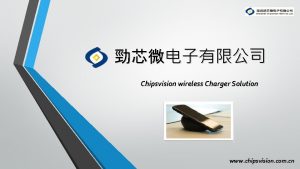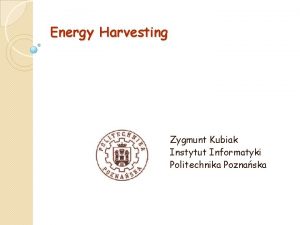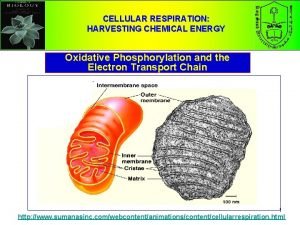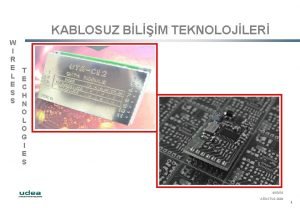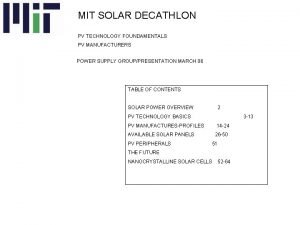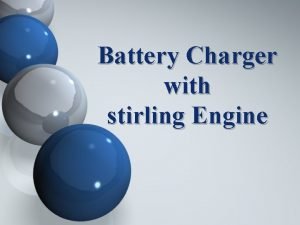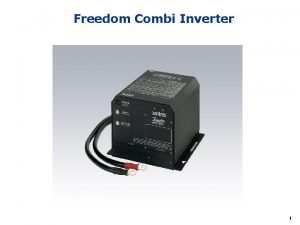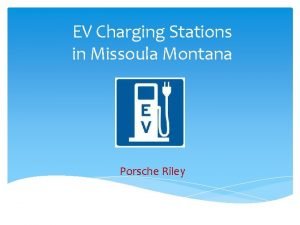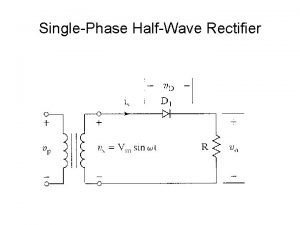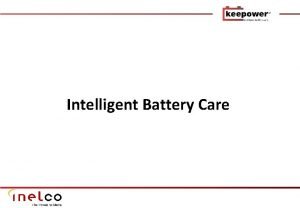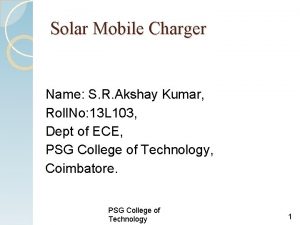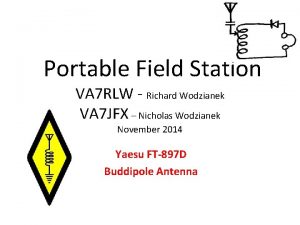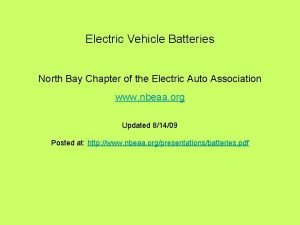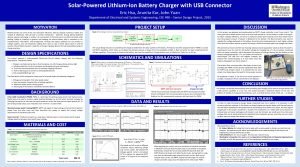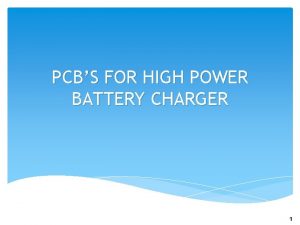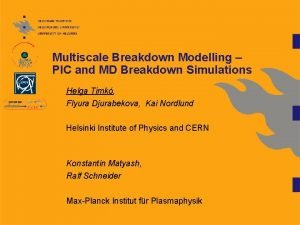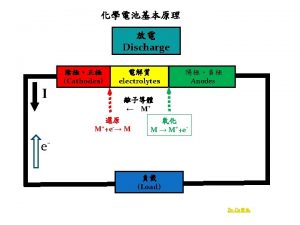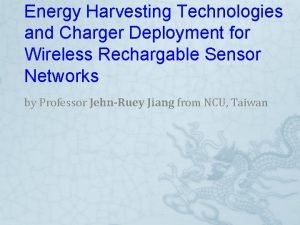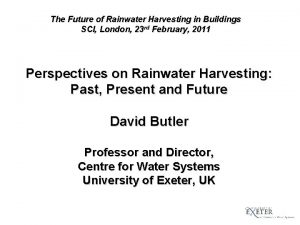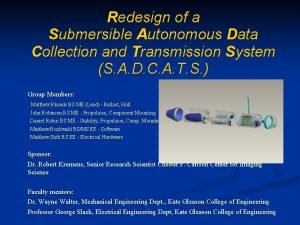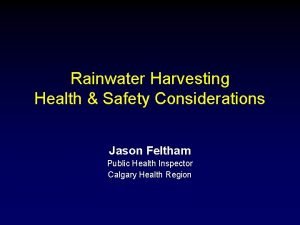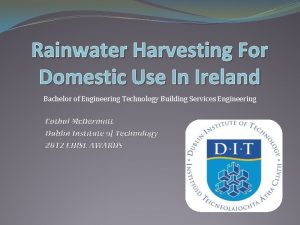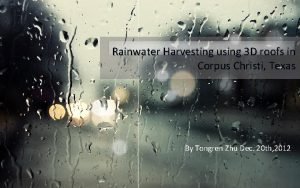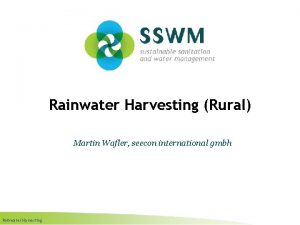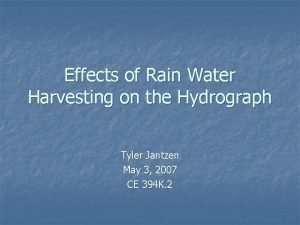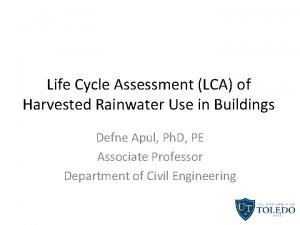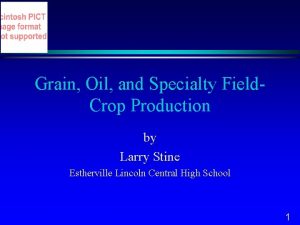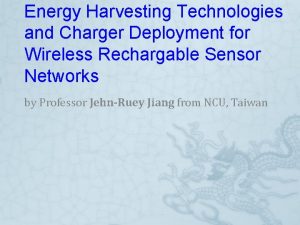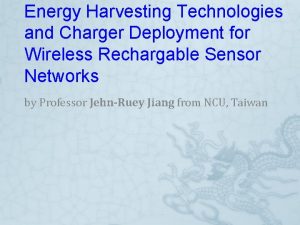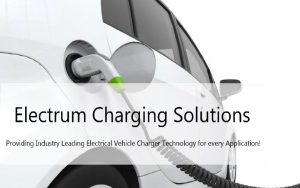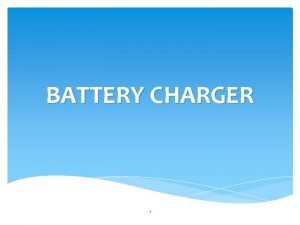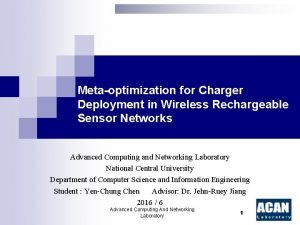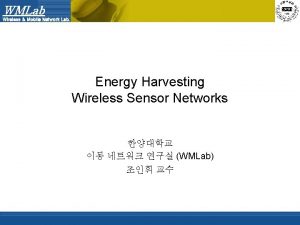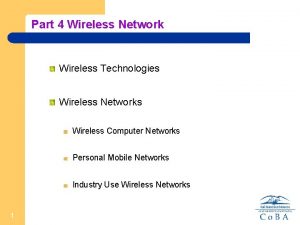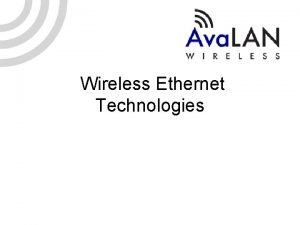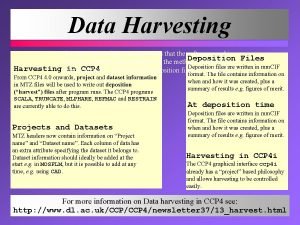Energy Harvesting Technologies and Charger Deployment for Wireless






































































- Slides: 70

Energy Harvesting Technologies and Charger Deployment for Wireless Rechargable Sensor Networks by Professor Jehn-Ruey Jiang from NCU, Taiwan

Part 1: Energy Harvesting Technologies

Energy Harvesting Source: http: //technologygreenenergy. blogspot. tw/2013/11/type-of-energy-sources. html 3

Types of Energy Harvesting Energy harvesting Thermal energy Body heat Water heat Other heat Mechanical energy Treading Vibrations Air flow Radiant energy Magnetic Induction Solar power RF 4

Thermal energy 5

Thermoelectric Effect Through thermoelectric effect, heat can be transformed into electricity. 6

Body Heat 7

Body Heat 8

Water Heat New thermoelectric material sucks electricity out of hot water 9

Other heat Cup of coffee too hot? Harvest some of that waste energy to charge your gadgets. 10

Mechanical energy 11

Piezoelectric Effect Through piezoelectric effect, electricity is generated when a piezoelectric plate vibrates (or is pressed/released). 12

Treading 13

Treading 14

Vibrations When we flap the plate, the plate vibrates and we gain electricity. 15

Air Flow A flapping leaf generator for air-flow energy harvesting 16

Radiant energy 17

Magnetic Induction 18

Magnetic Induction (MI) Change in the magnetic flux of the left coil induces a current in the right coil. 19

Solar Power 20

Photovoltaic Effect Through photovoltaic effect, light energy is transformed into electricity. Photovoltaic Effect 21

Xenon • The spectrum of a xenon lamp approximates that of the sun. So, it can be used as an “indoor solar power source. ” 22

RF Power Sources 23

Ambient (Anticipated or Unknown) RF • The credit-card-sized device can suck power out of the air from TV, cellular transmissions, and other RF signals. Ambient RF 24

Intentional RF - WISP (wireless identification and sensing platform) Tag Reader

WISP Tag Onboard sensors UHF RFID Tag Programmable Properties Passive

WISP Tag RFID Reader Passive Data Logger (PDL) Tag Sensor Storage Capacitor Analog Front End Antenna Power Management Microcontroller Flash Memory

Compatible with EPC G 2 tags Tag Reader Tag Memory ID Memory User Memory • Sensor Data • Charge remaining EPC ID • Time elapsed since last reset • Historical Sensor Measurements • Fully compatible with EPC Gen 2 specification

Intentional RF – Charger and Harvester 29

Powercast Technology Overview Trickle-charging means to charge a fully charged battery under no-load at a rate equal to its self-discharge rate, thus enabling the battery to remain at its fully charged level. 30

Powercast Recommended Power Profiles 31

Powercast Charger TX 91501 • 915 MHz center frequency • FCC and IC certified • 1 W or 3 W EIRP (Equivalent Isotropically Radiated Power) – TX 91501 -1 W-ID – TX 91501 -3 W-ID • ~60° beam pattern • Plug-and-play installation • Power virtually unlimited number of harvesters 32

Power Harvester P 2110 CSREVB • Convert RF input to DC current • Frequency range: 850 -950 MHz • Output voltage: 1. 8 V to 5. 25 V (configurable) • Range of at least 3 meters 33

Experiment Distance R 34

Experiment 0. 5 m 4. 21 4. 20 1. 0 m 4. 21 4. 20 0. 02 1. 5 m 4. 21 3. 04 2. 01 0. 02 2. 0 m 4. 21 4. 20 4. 19 1. 30 1. 01 -- 2. 5 m 4. 20 4. 19 2. 90 2. 46 0. 82 0. 02 -- 3. 0 m 2. 74 2. 39 1. 88 0. 73 0. 01 -- -- 3. 5 m 1. 01 0. 03 0. 02 0. 03 -- -- -- 4. 0 m 0. 04 -- -- -- 35

Experiment (Cont. ) 4. 5 4 3. 5 deg 0 3 deg 15 Voltage (V) 2. 5 deg 30 deg 45 2 deg 60 deg 75 1. 5 deg 90 1 0. 5 0 0 0. 5 1 1. 5 2 2. 5 3 3. 5 4 4. 5 Distance (m) 36

Experiment (Cont. ) 0. 5 m 35. 5 33. 6 26. 9 22. 7 12. 8 4. 20 2. 52 1. 0 m 7. 80 7. 65 4. 84 2. 94 1. 85 0. 49 0. 03 1. 5 m 4. 50 3. 58 2. 99 1. 98 0. 18 -- -- 2. 0 m 2. 78 2. 36 2. 04 1. 44 -- -- -- 2. 5 m 1. 31 0. 96 0. 79 0. 38 -- -- -- 3. 0 m 0. 75 0. 44 0. 37 -- -- 3. 5 m 0. 07 -- -- -- -37

Experiment (Cont. ) 40 35 30 deg 0 25 Current (m. A) deg 15 deg 30 20 deg 45 deg 60 15 deg 75 deg 90 10 5 0 0 0. 5 1 1. 5 2 2. 5 3 3. 5 4 Distance (m) 38

Powercast Charger Effective Charging Area Powercast wireless charger Powercast energy harvester 3 m 39

Wireless Rechargable Sensor Network Charger + Harvester + WSN (wireless sensor network) = WRSN (wireless rechargable sensor network) 40

Part 2: Charger Deployment for Wireless Rechargable Sensor Networks

Part 2: Outline Introduction � Problem Definition � Methods � Simulation � Conclusion � 42

WSN: Wireless Sensor Network Sensing Range Sink Node Sensor Node 43 Communication Range

Wireless Sensor Node Examples A wireless sensor node is a device integrating sensing, communication, and computation. It is usually powered by batteries. 44

Wireless Sensor Node Example: Octopus II MCU+Memory+RF Sensing Module + = • Developed in National Central University and National Tsin Hua University • MCU: TI MSP 430, 16 -bit RISC microcontroller core @ 8 Mz • Memory: 40 KB in-system programmable flash, 10 KB RAM, 1 MB expandable flash • RF: Chipcon CC 2420, 2. 4 GHz 802. 15. 4 (Zigbee) Transceiver (250 KBps) (~450 m) • Sensing Module: Temperature sensor, Light sensors, Gyroscope, 3 -Axis accelerometer • Power: 2 AA battery 45

WSN Application Example Temperature Humidity … Temperature Humidity … 46

Q: How to make WSNs sustainable? (hour) 47

A: WSN + RF Charger Energy Harvesting Energy Source: Charger Energy Harvester Energy-DC 48

Wireless Charging Model Charging Distance Charger Symmetrical Axis Vector Sensor Node 49

Scenario and Goals u Goal: Cover all sensor nodes with the u Assumption: minimum number of chargers to reduce • Sensor nodes in the WRSN can the charger deployment cost. be located on the ground or G H object surfaces in a cuboid. • The wireless chargers are assumed to be deployed at grid points on a grid of side length G. • Each grid point allows the deployment of several wireless chargers, each equipped with a directional antenna with an adjustable orientation. • Every node can decide the maximum number of chargers needed to make it sustainable. W L 50

Our Goal u Cover all sensor nodes with the minimum number of chargers to make the WRSN sustainable while keeping an as low as possible charger deployment cost.

Our proposed methods u. Two greedy heuristic algorithms to minimize the number of chargers. l NB-GCS (Node Based Greedy Cone Selection) l PB-GCS (Pair Based Greedy Cone Selection) 52

Candidate cone generation for NBGCS For each grid point, first select the sensor nodes within its sphere coverage. Then generate a vector for each node as the charger cone’s symmetric axis (or orientation). Charging Distance Grid Point g A B C E D 53

Candidate cone generation for NBGCS Each vector stands for a cone. For each cone, try to adjust its orientation for the cone to cover more nodes. g A B C E D 54

Candidate cone generation for NBGCS The cone orientation adjustment is done by unit vector summation. g A B C E D 55

Candidate cone generation for NBGCS g A B C E D 56

Candidate cone generation for NBGCS Iterations for node A stops if the cone orientation adjustment cannot make the cone cover more nodes. g A B C E D 57

Candidate cone generation for PBGCS For each grid point, first select the sensor nodes within its sphere coverage. Then generate a vector for each node as the charger cone’s symmetric axis (or orientation). Then for each pair of nodes (or vectors), generate candidate cones. Charging Distance Grid Point g A B C E D 58

Candidate cone generation for PBGCS Mapping each vector onto g’s unit sphere. There are three cases to consider. Unit sphere 1 r i Unit sphere g g 1 r r j i j 59

Candidate cone generation for PBGCS Unit sphere g 1 r i j 60

Greedy cone selection for both methods C 3 C 2 C 1 Return set is empty initially A #sensor a cone can cover B C D C 1 C 2 C 3 4 3 1 #chargers needed by a sensor A B C D 1 1 1 2 61

Greedy cone selection for both methods C 3 C 2 C 1 A B C D C 1 C 2 C 3 0 0 1 A B C D 0 0 0 1 62

Greedy cone selection for both methods C 3 C 2 C 1 A B C D C 1 C 2 C 3 0 0 0 A B C D 0 0 Finish! 63

Simulation Item Parameter Region #Sensors 50, 100, 150, 200, 250 Effective Charging Distance Angle Threshold The Height of the Deployment Plane Grid Length Simulator C++ 64

Simulation grid length = 1 • The most ideal case of 100%-0%, in which all sensor nodes need the 1 -coverage requirement 70 60 50 #chargers 40 PB-GCS: 100%-0% NB-GCS: 100%-0% 30 20 10 0 50 100 150 200 250 #sensors 65

Simulation grid length = 1 80% of nodes require 1 coverage and 20% of nodes require 2 covearge of chargers. 90 80 70 60 #chargers 50 NB-GCS: 80%-20% 40 PB-GCS: 80%-20% 30 20 10 0 50 100 150 200 250 #sensors 66

Simulation #sensors = 150 70 60 #chargers 56 56 55 53 50 64 61 60 51 49 44 48 44 • The influence of the grid side length on the number of chargers. • The smaller, the better. But the computation is also larger. PB-GCS: 100%-0% 40 NB-GCS: 100%-0% PB-GCS: 80%-20% 30 NB-GCS: 80%-20% 20 10 0 1 1. 4 1. 8 grid length 67

Part II: Short Summary � ü � Our contribution: Propose two near-optimal algorithms to minimize the number of chargers: NB-GCS & PB-GCS. Comparisons: Performance NB-GCS PB-GCS Good Better Time Complexity 68

Future Work � � Allow the deployment of chargers at any place Consider the obstacles between chargers and harvesters Design duty-cycle scheduling schemes for chargers to save energy Use novel heuristic or metaheuristic algorithms to solve the problem 69

Thank you! 70
 Cvs wireless charger
Cvs wireless charger Telecommunications, the internet, and wireless technology
Telecommunications, the internet, and wireless technology Cellular respiration harvesting chemical energy
Cellular respiration harvesting chemical energy Poznaska
Poznaska Explain how amp stimulates cellular respiration
Explain how amp stimulates cellular respiration Chapter 9: cellular respiration: harvesting chemical energy
Chapter 9: cellular respiration: harvesting chemical energy Phosphorelation
Phosphorelation Integrated wireless technologies
Integrated wireless technologies Udea wireless technologies ısıtıcı
Udea wireless technologies ısıtıcı Energy energy transfer and general energy analysis
Energy energy transfer and general energy analysis Energy energy transfer and general energy analysis
Energy energy transfer and general energy analysis Slurry definition cooking
Slurry definition cooking Xe rsm motorola red light
Xe rsm motorola red light Decathlon solar charger
Decathlon solar charger Stirling engine battery charger
Stirling engine battery charger Freedom combi inverter charger
Freedom combi inverter charger Ev charger installation montana
Ev charger installation montana Transformer utilization factor
Transformer utilization factor Language
Language Charger characteristics of life
Charger characteristics of life Solar mobile charger block diagram
Solar mobile charger block diagram Power pole battery charger
Power pole battery charger North bay lead acid flooded
North bay lead acid flooded Pkcell lp503562
Pkcell lp503562 Wholesale solar cells
Wholesale solar cells Pcb for power charger
Pcb for power charger Experimental plasma charger build
Experimental plasma charger build Pge level 2 charger rebate
Pge level 2 charger rebate Energizer 1 hour charger
Energizer 1 hour charger What is harves
What is harves Harvesting and marketing of fish
Harvesting and marketing of fish Conclusion of rain water harvesting
Conclusion of rain water harvesting Nbgcs
Nbgcs Harvesting strategy
Harvesting strategy Future of rainwater harvesting
Future of rainwater harvesting Autonomous data harvesting
Autonomous data harvesting Rainwater harvesting calgary
Rainwater harvesting calgary Rainwater harvesting system ireland
Rainwater harvesting system ireland Bibliography of rainwater harvesting
Bibliography of rainwater harvesting Harvesting ideas adalah
Harvesting ideas adalah Classification of fisheries
Classification of fisheries Harvesting the venture
Harvesting the venture Direct harvesting meaning
Direct harvesting meaning Outcome harvesting training
Outcome harvesting training Droofs
Droofs Function of rainwater harvesting
Function of rainwater harvesting Rain water harvesting
Rain water harvesting Coarse mesh in rainwater harvesting
Coarse mesh in rainwater harvesting Rainwater harvesting introduction
Rainwater harvesting introduction Simpson sod
Simpson sod Corkglass
Corkglass Rain water harvesting autocad drawing
Rain water harvesting autocad drawing Life cycle assessment of rainwater harvesting
Life cycle assessment of rainwater harvesting Conclusion on rainwater harvesting
Conclusion on rainwater harvesting The primary harvesting machine used for field crops is the:
The primary harvesting machine used for field crops is the: Outcome harvesting methodology
Outcome harvesting methodology Micro catchment water harvesting
Micro catchment water harvesting Formuö
Formuö Typiska drag för en novell
Typiska drag för en novell Tack för att ni lyssnade bild
Tack för att ni lyssnade bild Ekologiskt fotavtryck
Ekologiskt fotavtryck Shingelfrisyren
Shingelfrisyren En lathund för arbete med kontinuitetshantering
En lathund för arbete med kontinuitetshantering Personalliggare bygg undantag
Personalliggare bygg undantag Tidbok för yrkesförare
Tidbok för yrkesförare Sura för anatom
Sura för anatom Vad är densitet
Vad är densitet Datorkunskap för nybörjare
Datorkunskap för nybörjare Stig kerman
Stig kerman Debatt artikel mall
Debatt artikel mall Delegerande ledarskap
Delegerande ledarskap
